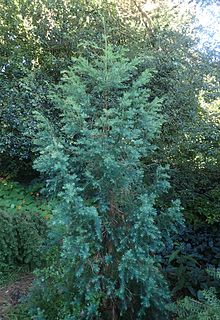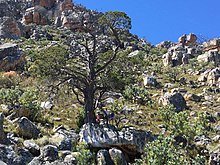Widdringtonia
| Widdringtonia | ||||||||||||
|---|---|---|---|---|---|---|---|---|---|---|---|---|

Widdringtonia whytei on the Mulanje plateau in Malawi |
||||||||||||
| Systematics | ||||||||||||
|
||||||||||||
| Scientific name | ||||||||||||
| Widdringtonia | ||||||||||||
| Final |
Widdringtonia , also known as African cypress , is a genus of plants in the cypress family (Cupressaceae).
description
The Widdringtonia species are characterized by the fact that they are well adapted to fire ( forest fire ).
The Widdringtonia species are evergreen shrubs or trees . The wood smells aromatic. The plants form different youth (juvenile) and age (adult) leaves. The juvenile - leaves are arranged spirally and needle-like, the adult leaves pressed scale-like and closely to the branches, thereby against or alternate.
The Widdringtonia species are single sexed ( monoecious ). The male cones are around four millimeters long and end on short side branches. The female cones are woody and 13 to 25 millimeters in diameter. They stand individually or in groups on long shoots . The cone scales are four, less often six, in several consecutive whorls . The female cones open for pollination and then close again. Each cone scale is thickened and lignified at the apical end. Several ovules sit at the base of the cone scales . The seeds have paper-like wings.

Danger
The stocks of the Widdringtonia species have declined sharply due to deforestation . Extensive forests with Widdringtonia species can only be found on the slopes of Mount Mulanje in Malawi .
Systematics and distribution
The genus Widdringtonia was named by Stephan Ladislaus Endlicher in honor of Samuel Edward Widdrington (1787-1856) (actually Samuel Edward Cook, he took his mother's name in 1840), an English naval officer and writer who also collected plants. Synonyms of Widdringtonia Endl. are: Pachylepis Brongn. , Parolinia Endl.
The three or four Widdringtonia species belong to the few species of the order of the pine-like (Pinales) that occur in sub- Saharan Africa . They grow in the Republic of South Africa , Malawi , Mozambique and Zimbabwe .
Depending on the author, there are three to seven species in the genus Widdringtonia :
- Milanji African cypress ( Widdringtonia nodiflora (L.) Powrie ): It is common in Malawi , Mozambique and Zimbabwe to South Africa.
- Black's African cypress ( Widdringtonia schwarzii ( Marloth ) Mast. ): It occurs only in the Eastern Cape .
- Clanwilliam African cypress ( Widdringtonia wallichii Endl. Ex Carrière , Syn .: Widdringtonia cedarbergensis J.A. Marsh ): It occurs only in the Cedar Mountains in South Africa.
- African cedar or Whytes African cypress ( Widdringtonia whytei Rendle , Syn .: Widdringtonia nodiflora var. Whytei (Rendle) Silba ): It occurs only in Malawi in the Mulanjemassiv and on Mount Mchese.
literature
- Colin Tudge : The secret life of trees , Penguin books, London 2006, ISBN 978-0-14-101293-3
- Walter Erhardt among others: The big pikeperch. Encyclopedia of Plant Names . Volume 2. Verlag Eugen Ulmer, Stuttgart 2008. ISBN 978-3-8001-5406-7
Individual evidence
- ↑ Lotte Burkhardt: Directory of eponymous plant names . Botanic Garden and Botanical Museum Berlin, Free University Berlin Berlin 2016. ISBN 978-3-946292-10-4 , page 1082. doi : 10.3372 / epolist2016
- ^ Armin Jagel, Veit Dörken: Morphology and morphogenesis of the seed cones of the Cupressaceae - part III. Callitroideae. In: Bulletin of the Cupressus Conservation Project , number 10, volume 4, number 3, December 19, 2015, pp. 91-103 ( PDF )
- ↑ a b c d Rafaël Govaerts (Ed.): Widdringtonia. In: World Checklist of Selected Plant Families (WCSP) - The Board of Trustees of the Royal Botanic Gardens, Kew . Retrieved March 20, 2019.
Web links
- Christopher J. Earle: Widdringtonia. In: The Gymnosperm Database. December 12, 2010, accessed October 25, 2011 .
- Widdringtonia on the Germplasm Resources Information Network (GRIN), USDA , ARS , National Genetic Resources Program. National Germplasm Resources Laboratory, Beltsville, Maryland.

